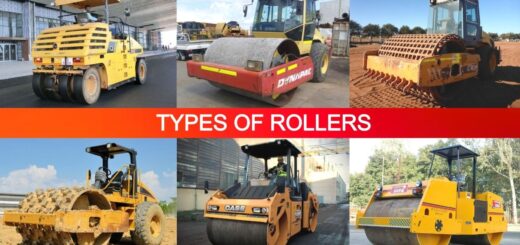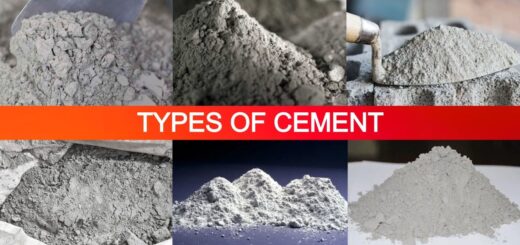What is Shoring? 12 Types of Shoring, Importance & Requirements [Explained with Complete Details]
![What is Shoring? 12 Types of Shoring, Importance & Requirements [Explained with Complete Details]](https://engineeringlearn.com/wp-content/uploads/2023/01/Shoring-1024x539.jpg)
What is Shoring?
What is Shoring? 12 Types of Shoring, Importance & Requirements [Explained with Complete Details]: – Shoring is a temporary structure used to forestall the collapse of the fundamental under-construction structure. It is by and large required to balance out the construction pit walls, prevent water from entering the pit and secure adjoining buildings. Shoring in Construction is basically required to support a profound excavation to keep the retained soil from overturning and in the long run causing a venture mishap. Its support requirement depends upon the types of soil and when an excavation profundity is at least a 1.20-meter contrast in levels from ground level.
Shoring structures are totally different from retaining walls, as this is utilized exclusively to hold the soil during the excavation. According to the structural designers, it isn’t utilized to only retain the soil. It is generally fundamental to decide which kind of shoring is suitable for the construction project that you are taking part in at the beginning phase of the design.
Building construction in a metropolitan region with a high building density around requires special consideration. Surrounding building structures and traffic structures should be secured and frequently require extensive efforts in regards to shoring and dewatering for the excavation of the new structure.
There is one more significant issue to decide the utilization of the temporary measures additionally for the final building structure. It is basically required on the off chance that a massive and exorbitant strategy like diaphragm walls is mandatory due to Geo-technical demand. These sorts of walls can be utilized as long-lasting walls for example in metro stations or basements of high-rise buildings.
What is Shoring in Construction?
Shoring is a temporary structure used to prevent the collapse of the main under-construction structure. The most commonly shoring support is required during the early stage of construction which is excavation.
Why there is Requirement of Shoring?
- Assuming the wall show signs of bulging out because of terrible workmanship.
- To fix a crack on the wall because of inconsistent settlement of the foundation.
- At the point when an adjacent structure is to be dismantled.
- Assuming that openings are to be made or expanded in the wall.
- To give support to walls that are dangerous or are probably going to become unstable due to subsidence, bulging, or inclining.
- For staying away from failures of sound walls brought about by the removal of underlying support
Different Types of Shoring
1. H and I-beam Shoring: ( Types of Shoring )
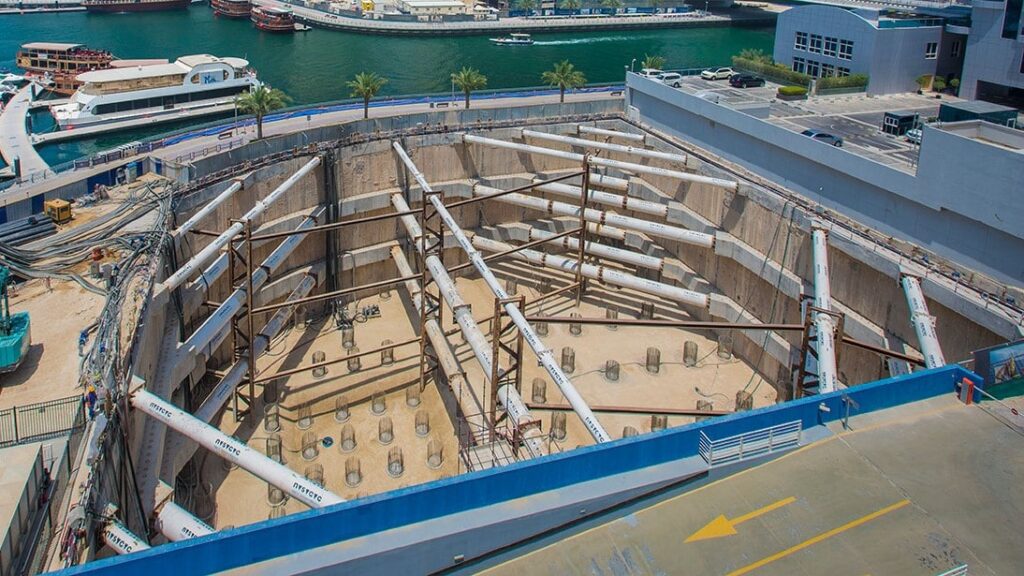
H and I-beam shoring, otherwise called soldier pile walls, upholds excavation endeavors that have a depth of 50 inches to 200 inches. Contingent upon the type of soil that experts use while utilizing H and I-beam shoring, they can either install pre-fabricated steel beams into the ground utilizing a drill or embedded the steel into the pillars into the ground without drilling first. To build the shoring wall, experts place concrete panels between the steel beams after they’re placed in the soil.
2. Contiguous Pile Shoring: ( Types of Shoring )
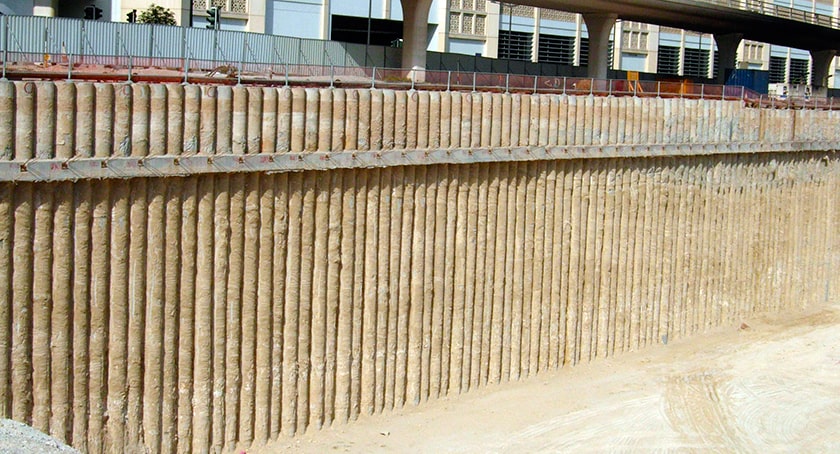
Contiguous pile shoring, which is otherwise called tangent pile shoring, can be useful for construction sites that have less water pressure or water accessibility. To create the contiguous pile shoring type, professionals put piles, which are long cylinders made of concrete, close to one another to create long rows that are firmly dispersed. This type of shoring can assist with keeping materials dry. In the event that utilized in a wet climate, water can seep through the piles and prompt materials to get wet.
3. Secant Pile Shoring: ( Types of Shoring )
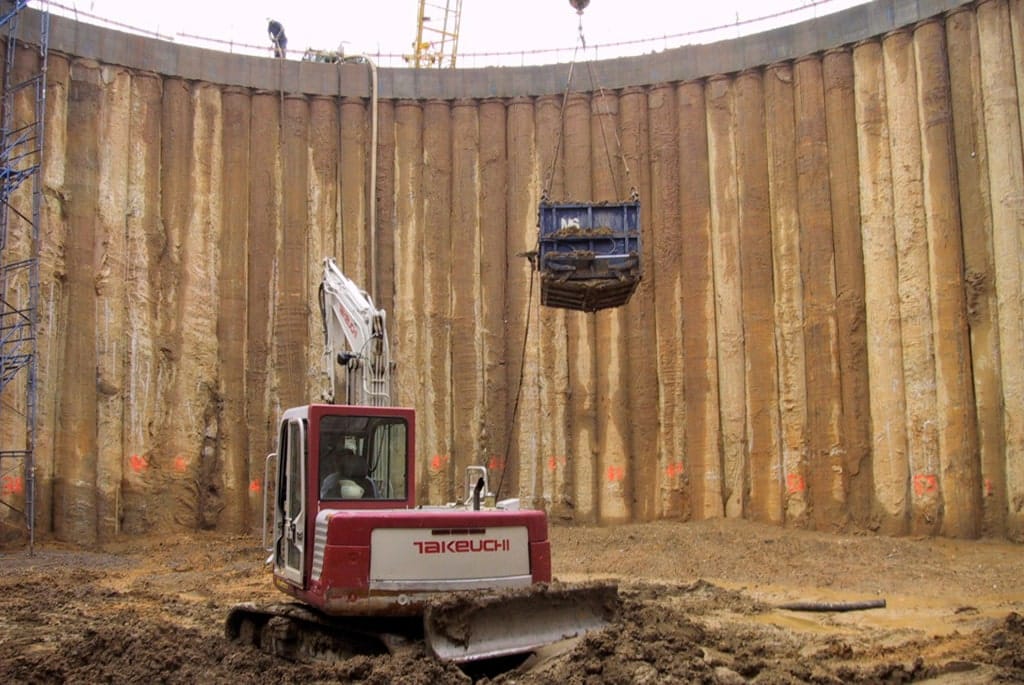
Secant pile shoring includes converging two walls that interlock together and structure a continuous wall. Experts refer to one wall as the primary wall, which is the sturdier wall, and the other wall as the secondary wall, which is the temporarily unstable wall. Experts utilize this shoring when there are no options available for open excavations, typically in light of the fact that there are different structures that are excessively close to the construction site. Experts should be careful while constructing the secant pile shoring type since they frequently use it when they are close to a standing structure.
4. Raking Shoring: ( Types of Shoring )
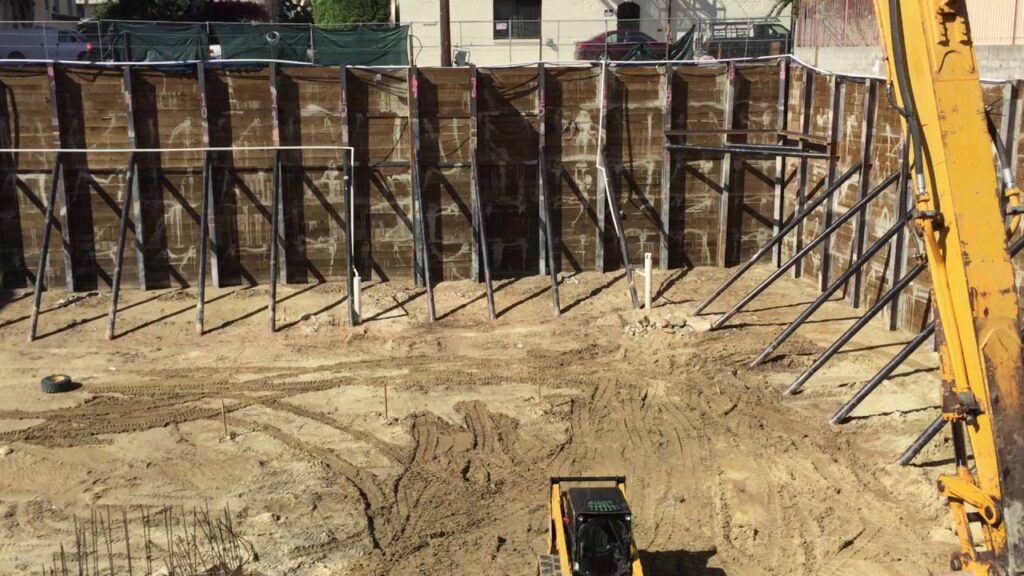
Rake shoring is utilized to support any walls that aren’t structurally sound within a building. Utilizing cleats, needles, sole plates, inclined members, supporting and wall plates, they help to watch out for walls to limit any harm to the current structure or design. It is utilized to transfer the floor and wall loads to the existing building using inclining swaggers or rakers. The rakers should be positioned accurately so they are capable following components rakers, wall plates, needles, spikes, propping, and sole plate.
Rakers against the needles so that the center-line of the raker and the wall meet at the floor level. Hence, there will be one raker compared to each floor. These rakers are interconnected by struts, to forestall their clasping. An inclined sole-plate is embedded into the ground on which the feet of rakers are associated. The feet of rakers are additionally hardened close to the sole plate utilizing hoop iron. The wall plate conveys the pressure to the wall consistently.
5. Hydraulic Shoring: ( Types of Shoring )
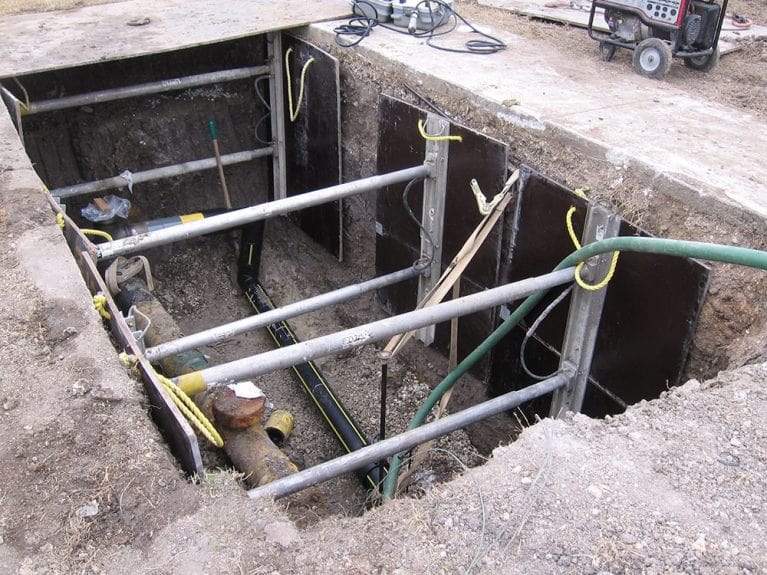
Experts utilize hydraulic shoring when they need to finish an excavation job quickly since hydraulic shoring is a faster and more straightforward type of shoring. They normally utilize other shoring techniques for longer excavation jobs, however, hydraulic shoring is ideal for short-term excavations since the equipment utilized in this kind of shoring is simpler to manage. To operate hydraulic shoring, experts utilize hydraulic pistons, which are cylinders that water pushes through at a rapid speed. They pump the hydraulic pistons outward until they’re hitting the walls that required support. Typically, experts place steel plates against the walls as a target for the pistons.
6. Soil Nail Shoring: ( Types of Shoring )
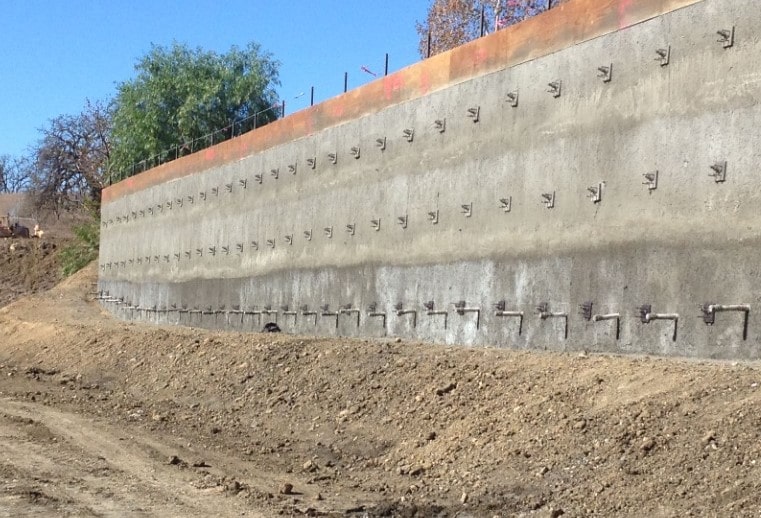
Soil nail shoring strengthens soil slopes and walls by installing reinforcement components, similar to steel bars or nails. Experts drill a hole in the soil, then, at that point, place the reinforcement material close to the unstable structure. They put the material at a descending point to offer more stability and better security against any natural threats, similar to wind.
7. Timber Shoring: ( Types of Shoring )
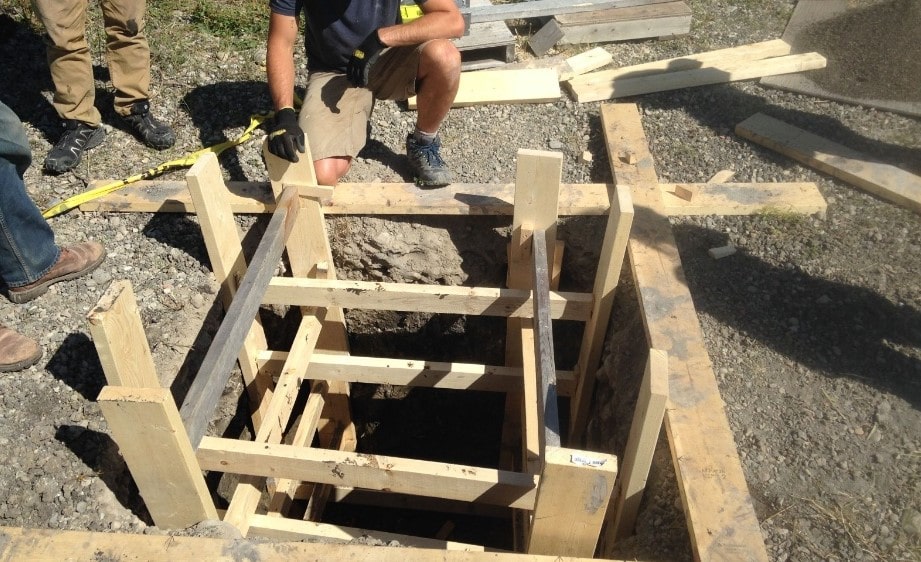
Experts use timber shoring for a large assortment of circumstances like they can’t utilize other shoring options or while accessing small excavation regions. Timber shoring is when experts use shoring materials to support structures that run on a level plane along trenches. The materials assist experts with getting entrance into more modest spaces, which can assist them with digging further into channels. Here is a portion of the materials utilized in lumber shoring:
A) Waler
This is a horizontal beam that experts can connect to structures utilizing bolts. They come in different sizes, contingent upon the depth of the trench.
B) Trench Jack
This hardware sits on top of walers that interface them to the structure. They keep the waler and structure held in place and supports the structure, help the design, and set straightforwardly beneath the construction to keep it durable.
8. Pneumatic Shoring: ( Types of Shoring )
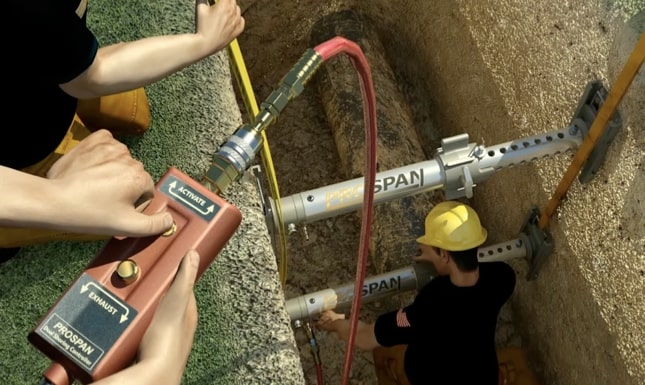
Pneumatic shoring utilizes air pressure to keep structures upstanding utilizing air compressors. The air compressor converts power, utilizing electric energy or gas, into energy that can pressurize air and utilize high pressure force to keep structures back from falling.
9. Sheet Piles: ( Types of Shoring )
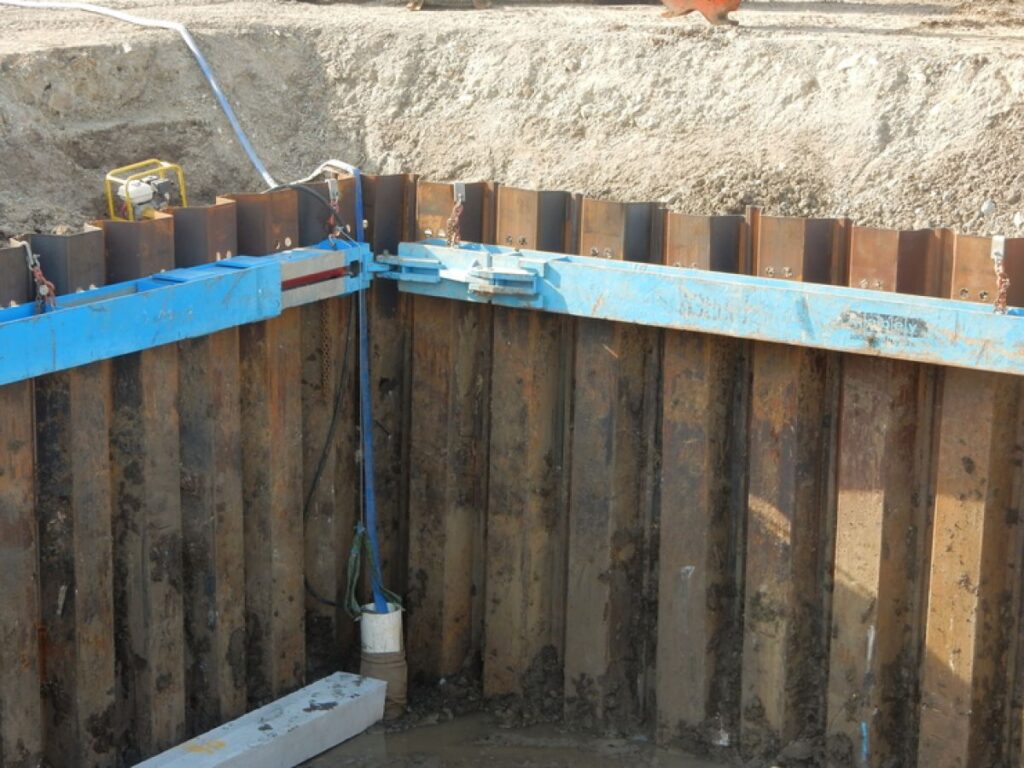
Experts can create sheet piles by utilizing a vibratory hammer which is a hammer that utilizes vertical vibrations to cut through steel. They drive the hammer through pre-fabricated steel and into the ground, which assists the wall with remaining upstanding. The shoring wall is a consequence of the associated sheet piles. Experts can utilize sheet piles to retain soil with soil excavations, and it is likewise an optimal decision for excavations close to a waterway since the sheets can keep the water back from getting through the wall.
10. Dead Shoring: ( Types of Shoring )
Dead shoring is utilized to temporarily support the walls, rooftops, floors, and so forth, by providing horizontal members known as needles. This sort of shoring is utilized to support dead loads that act vertically downwards. It comprises a vertical prop or shore leg with a head plate, sole plate, and a few methods for change for fixing and facilitating the shore. The standard arrangement is to utilize two sore legs associated over their heads by a level bar or needle.
The heaps are moved by the needle to the shore legs and consequently down to a strong bearing surface. Dead shoring is utilized to construct the lower part of a defective load-bearing wall, develop the current establishments, which have either become hazardous or require reinforcing, and huge openings in the current walls for entryways and windows. This kind of shoring framework is kept away from the wall for simple repair work. Dead shores are supported and anchored on plates and folding wedges.
11. Flying Shoring: ( Types of Shoring )
Flying shoring is a support system that offers horizontal support to two parallel party walls when removal or collapse of the intermediate building takes place. These are most frequently utilized for supporting temporarily the parallel walls of two adjacent buildings where an intermediate building must be destroyed or modified. Basically, the framework would be built through the middle and ‘wedge’ between the adjacent buildings. The flying shore comprises wall plates, swaggers, stressing pieces, flat shore, needles, spikes, and wedges. Like inclined shores, in this framework additionally, the wall plates are secured against the walls utilizing needles and cleats.
In this kind of shoring additionally, the wall plates are set against the wall and secured. A horizontal strut is set between the wall plates and is supported by a system of needles and cleats. The inclined struts are supported by the needle at their top and by stressing pieces at their feet.
12. Diaphragm Walls: ( Types of Shoring )
Experts typically use diaphragm walls when any remaining shoring types are not strong enough able to arrive at deep excavations. Experts utilize supported concrete while creating diaphragm walls, which are more grounded and endures longer than the other shoring types, however, it is harder to eliminate diaphragm walls once the excavation is finished. Diaphragm walls are a good choice for the excavation of deep tunnels or basements.
Why Shoring is Important?
Below are some important points which describe why shoring is important:
A) Saves a Lot of Time
Reliable work executed by shoring workers or contractors will forestall the wastage of materials and time. In the event that it’s not done properly then a structure, trench, or soil can collapse and though nobody will be harmed, it will burn through a lot of time in re-doing the work.
B) Gives Peace of Mind
In the event that specialists constantly have fear of trench collapse, they will not have the option to work productively and rapidly. They will definitely make errors without appropriate support around them.
C) Secures Our Finances
A well-executed shoring makes work simple, safe, speedy, and modest. For instance, in the event that a trench collapses, it won’t just cost money to re-dig and repair or replace whatever was harmed, however on the off chance that anything unsafe happens to laborers, one needs to confront claims assuming specialists are harmed.
D) Makes the Future Safe
In the event that an individual requires a strong completion, he/she wants to have a top-notch starting point for a task. While shoring works done well, it makes the fate of a house, as well as individuals calling it home, brilliant, secured and strong.
E) Lower Costs
Shoring brings down the cost as, through it, it is a lot more easier for builders to stay on a budget as they don’t need to confront the opportunity of collapsed excavations
F) Expedited Scheduling
In the event that workers have tore-dig a site two times, it costs delays that can throw shoring contractors off schedule. In the event that laborers have tore-dig a site two times it costs defers that can lose shoring project workers plan. Similarly, employees who aren’t worried over their own security will be less inclined to make blunders that can result in lost time.
G) It Enhances and Guarantees Safety of the Employees
The construction industry itself is an exceptionally perilous job. At the point when workers are working on a construction project, they need fitting support to the soil or structure to forestall mishaps. It improves and ensures the safety of the workers.
Conclusion
Shoring is incredibly significant for overwhelming different reasons. In the event that you maintain that your workers should be safe, and keep away from costly repairs and wasted time, you really want to utilize trench shoring whenever you have individuals working in trenches. Not exclusively will it set aside your time and money, yet more critically it will save your employee’s lives. Your selection will be subject to the need and support and stability of the hazardous designs. Shoring can offer support to the structures when certain modifications) are important to be done in the structure when it is going through repair work.
Content Source: – constrofacilitator, indeed, universalpiling
Image Source: – nsccme, swissboring, morrisshea, lusdatuac, ntsafety, dakotadrilling, cawst, prospanshoring, mabeyhire,
